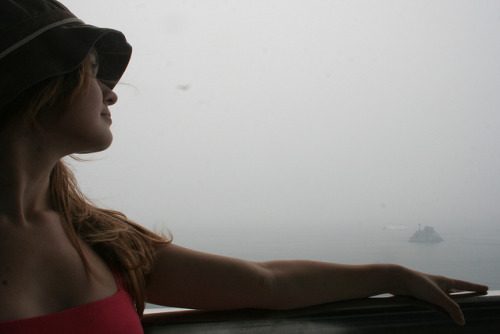#yomibitoshirazu
Dokdo Romance on Flickr.
水霧相 奥津小嶋尓 風乎疾見 船縁金都 心者念杼
水霧らふ沖つ小島に風をいたみ舟寄せかねつ心は思へど
minagirapu/oki tu kosima ni/kaze wo itami/pune yosekanetu/ kokoro pa omopedo
Mist settles over the waters in the offing, and so held back by the wind, to the small island the boat cannot draw near; although it very much wishes to do so.
(Man’yoshu 7-1401, Anonymous)
This is an old photo from the summer of 2010, taken in Pusan; I found it an amusing companion to this poem as Evelyn and I had decided that the tiny island was Dokdo (a disputed island between Korea and Japan), although of course it is not the actual one, but “Dokdo” literally means “solitary island,” so we thought it an appropriate name for this tiny one. Given the way I am gazing longingly at this poor lonely island, I decided it worked well with this poem. The poem is generally read symbolically, i.e. that the “small island” is a lover to whom one cannot draw near due to being obstructed (by the “wind”) and the view of whom is obscured (by the “mist” settling over the water). The photo also has a boat barely visible, which is interesting. The poem is lamenting the inability to meet one’s lover due to some sort of obstacle, and declares the desire to meet, but contains a hint of desperation that the obstacles cannot be overcome; although the desire is there, “wind” and “mist” are natural phenomena over which man has no control. These therefore might understood symbolically as obstacles outside of one’s control, such as social protocol/standards/class divisions or even family, rumors, etc. Likewise, I could never approach that island, not only because of the mist and the wind, but because I am deathly afraid of fish and will not go in the ocean.
Post link
IMG_4083 on Flickr.
紫之 根延横野之 春野庭 君乎懸管 鴬名雲
紫草の根延ふ横野の春野には君を懸けつつ鴬鳴くも
Murasaki no/nebapu yokono no/paru no ni pa/kimi wo kaketutu/ugupisu naku mo
In the spring fields of Yokono, where the roots of the purple gromwell flourish, a single warbler cries out—you on its mind.
(Man’yoshu 10-1825, Anonymous)
I realize this photo is not of an actual murasaki(gromwell) plant, but is rather the Penstemon margarita (I came to this conclusion based on some web searching for native California plants, but I may be wrong), but I liked the photo, and I love the poem, so… The image of a bird crying out for its mate in a field lush with vegetation, is deeply evocative and becomes somewhat standard for representing a woman left behind, crying for her mate in a place devoid of human life (i.e., the Fukakusa no sato story in Ise), but this is an interesting early example, coming from MYS, in that one would expect such a poem to feature darker imagery, but here we have a bright spring scene full of flourishing greens (whereas later we might expect a desolate autumn landscape and a chill wind). The brightness of the scene not only further reinforces the fact that “standard” imagery was not yet established in the time of the MYS, but also allows us to imagine that although she may be longing for her lover, he may possibly return, as a result of hearing her cries. There is some degree of hope here… the poet is the warbler, singing her song aloud, in hopes that it will be heard and he will return, and not just as a means of catharsis. One can imagine such a poem as being part of an exchange in its original incarnation.
Post link


